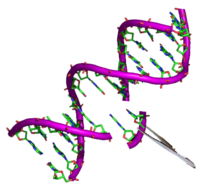
Photo from wikipedia
Modern antiretroviral therapy for immunodeficiency viruses, although remarkably effective in controlling viral transcription, and overt virus-associated morbidity, has failed to absolutely eradicate retroviruses from their infected hosts as a result… Click to show full abstract
Modern antiretroviral therapy for immunodeficiency viruses, although remarkably effective in controlling viral transcription, and overt virus-associated morbidity, has failed to absolutely eradicate retroviruses from their infected hosts as a result of proviral integration in long-lived reservoir cells. Immunodeficiency virus-infected patients are therefore consigned to lifelong antiviral therapy as a means to control viremia, viral transmission, and infection-associated morbidity. Unfortunately, lifelong antiviral therapies can be difficult for patients to continuously maintain and may be associated with therapy-specific morbidities. Patient advocates have argued for new methods to achieve retroviral eradication. As a proof-of-concept study, a lentivirus-delivered RNA-directed gene editing strategy was utilized in a series of in vitro experiments in an attempt to attenuate the feline immunodeficiency virus (FIV) proviral load, viral transcription, and production of infectious virions. We found that a feline T lymphocyte cell line (MCH5-4) treated with an FIV-specific clustered regularly interspersed short palindromic repeats (CRISPR)-associated protein 9 (Cas9) gene editing tool resulted in a reduction of cell-free viral RNA relative to control cells. Decreased infectious potential was demonstrated in a two-step FIV infection study—naïve MCH5-4 cells infected with cell-free FIV harvested from FIV-infected and CRISPR lentivirus-treated cells had less integrated proviral DNA than control cells. This study represents the initial steps towards the development of an effective method of proviral eradication in an immunodeficiency virus-infected host.
Journal Title: Viruses
Year Published: 2020
Link to full text (if available)
Share on Social Media: Sign Up to like & get
recommendations!